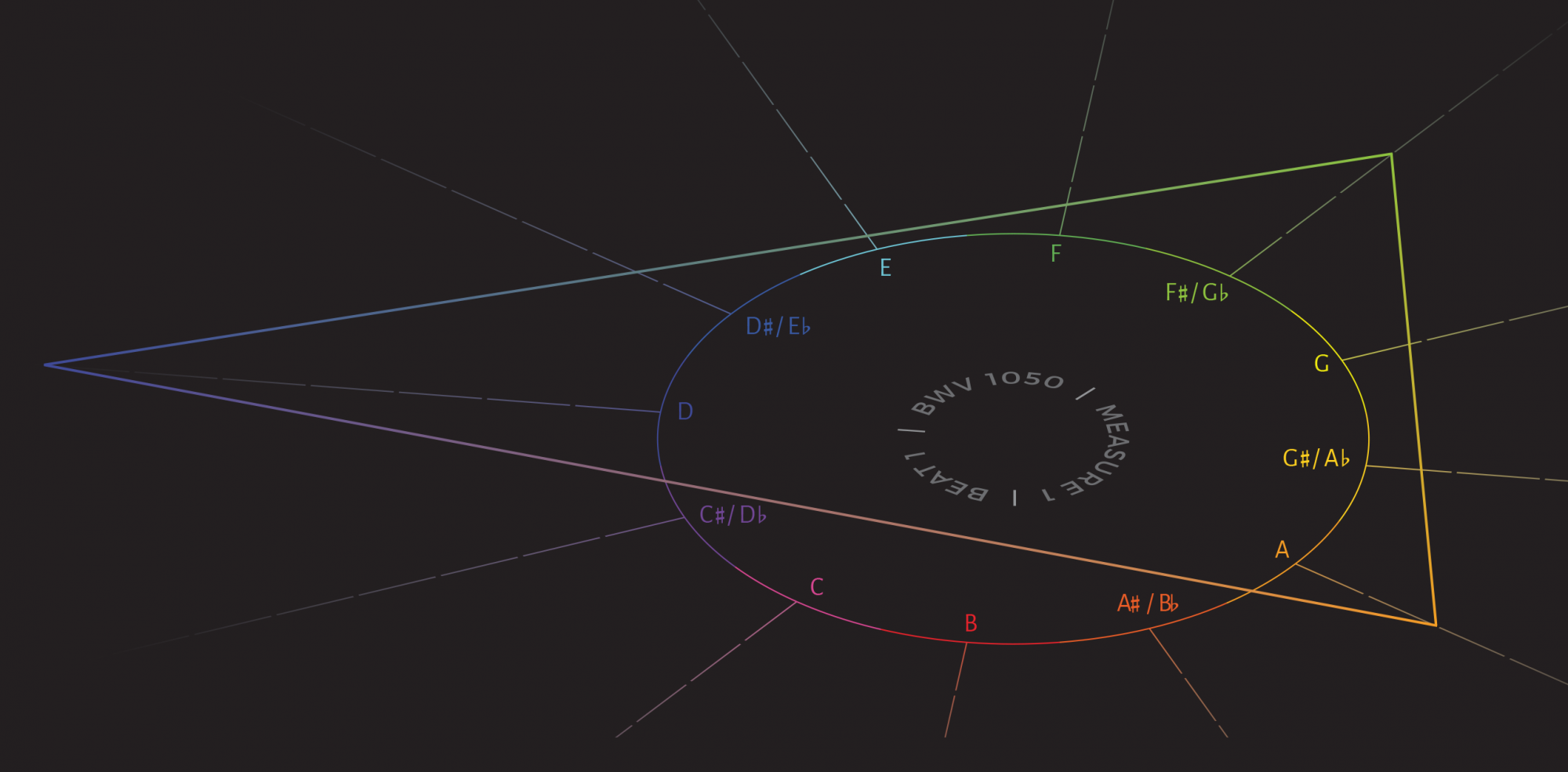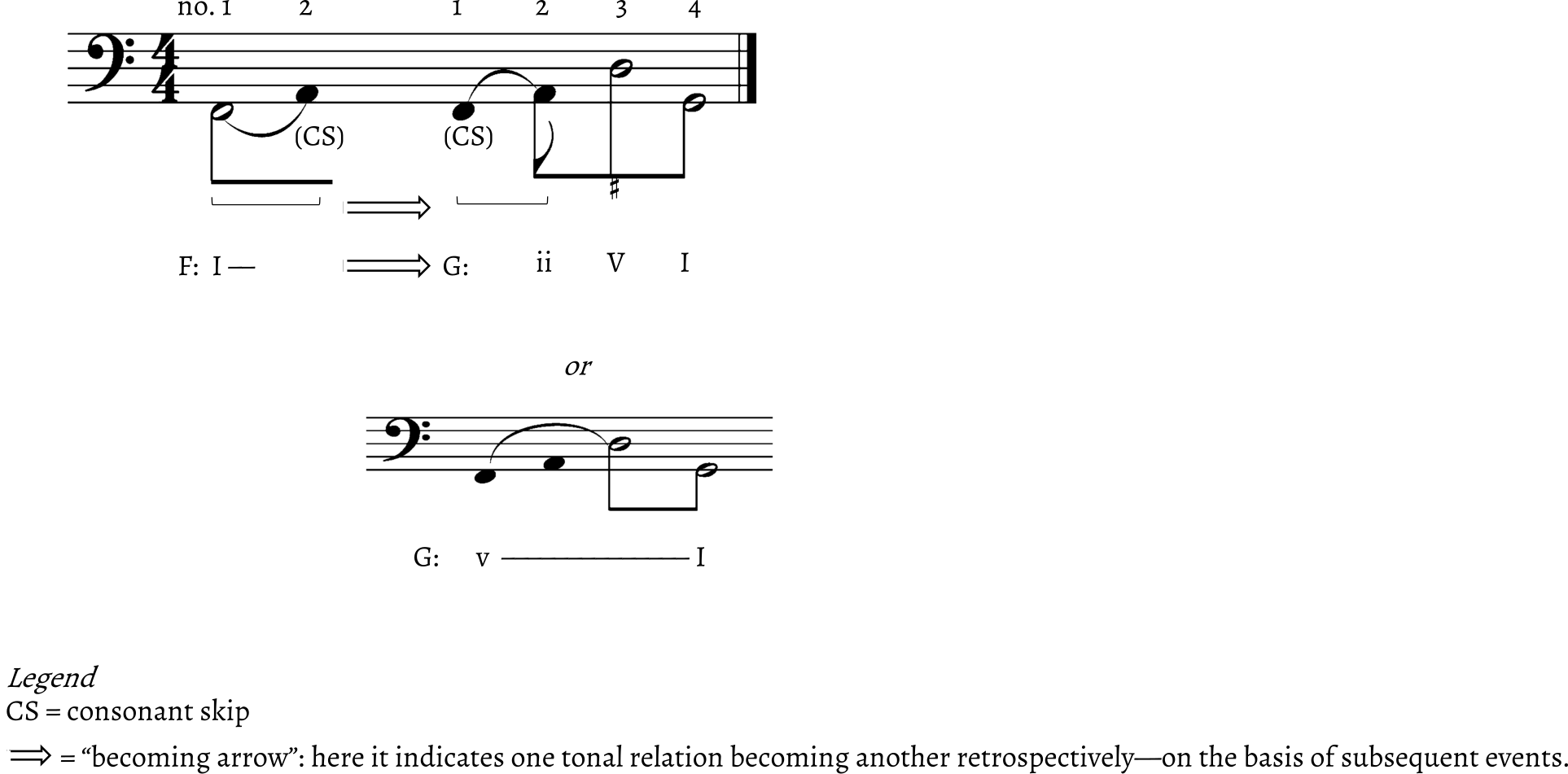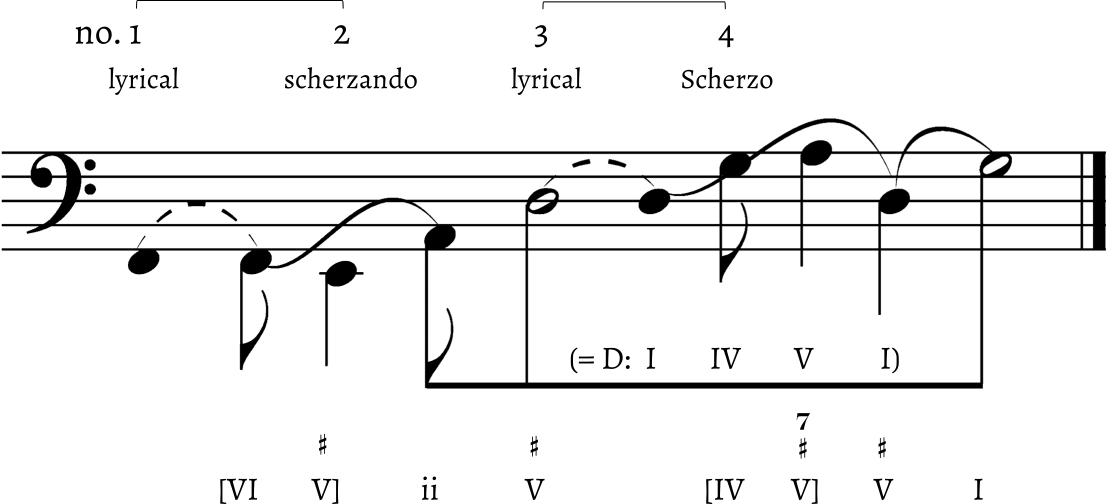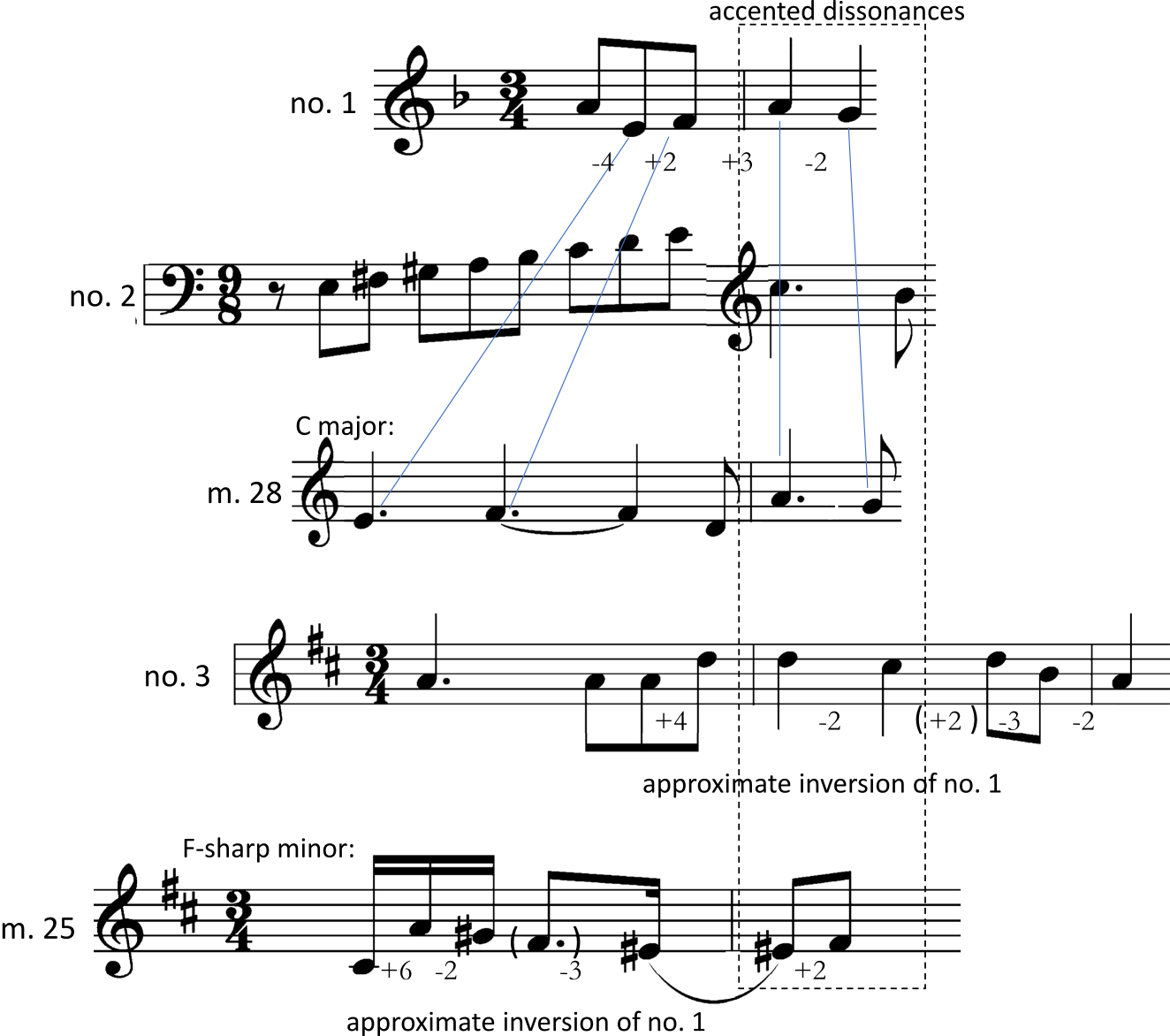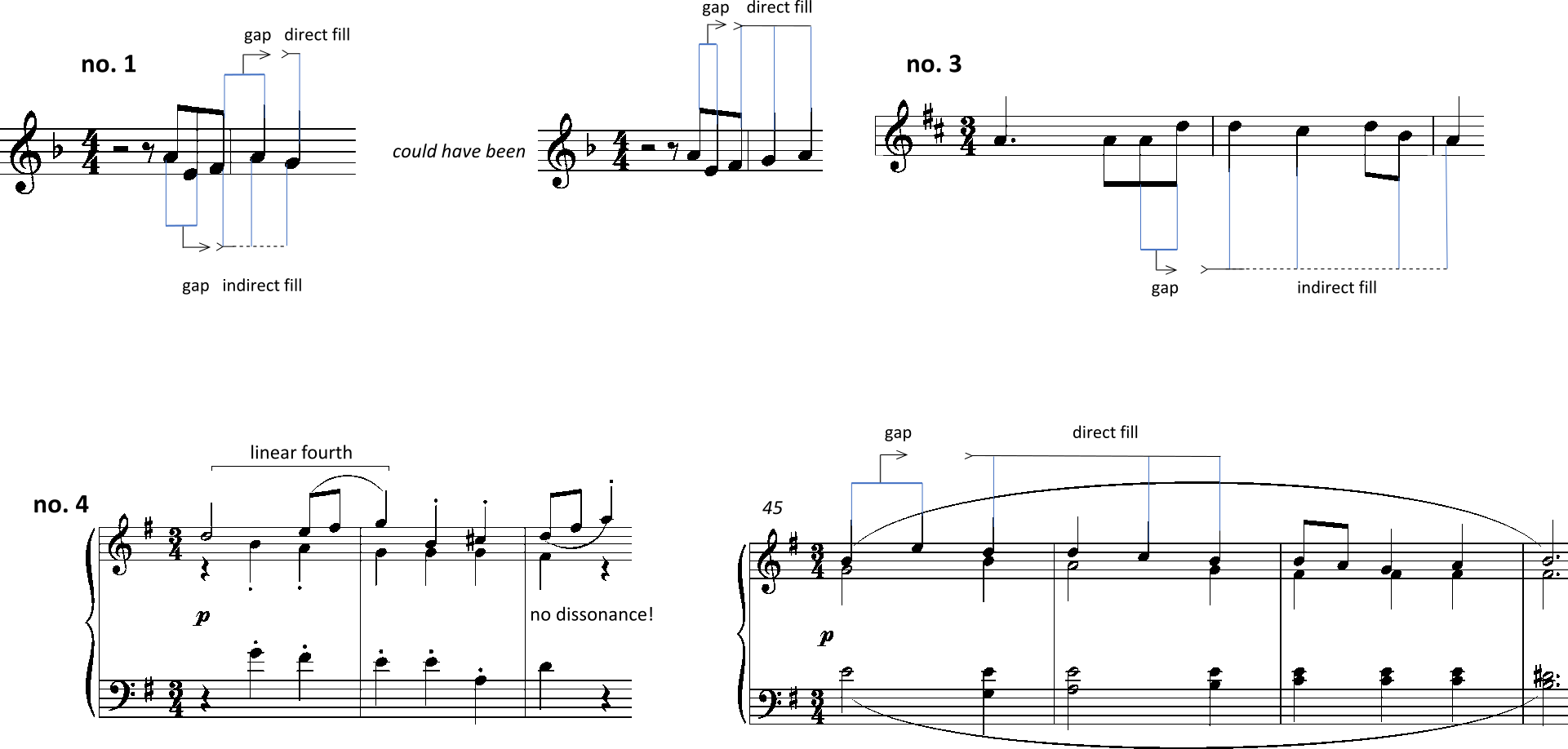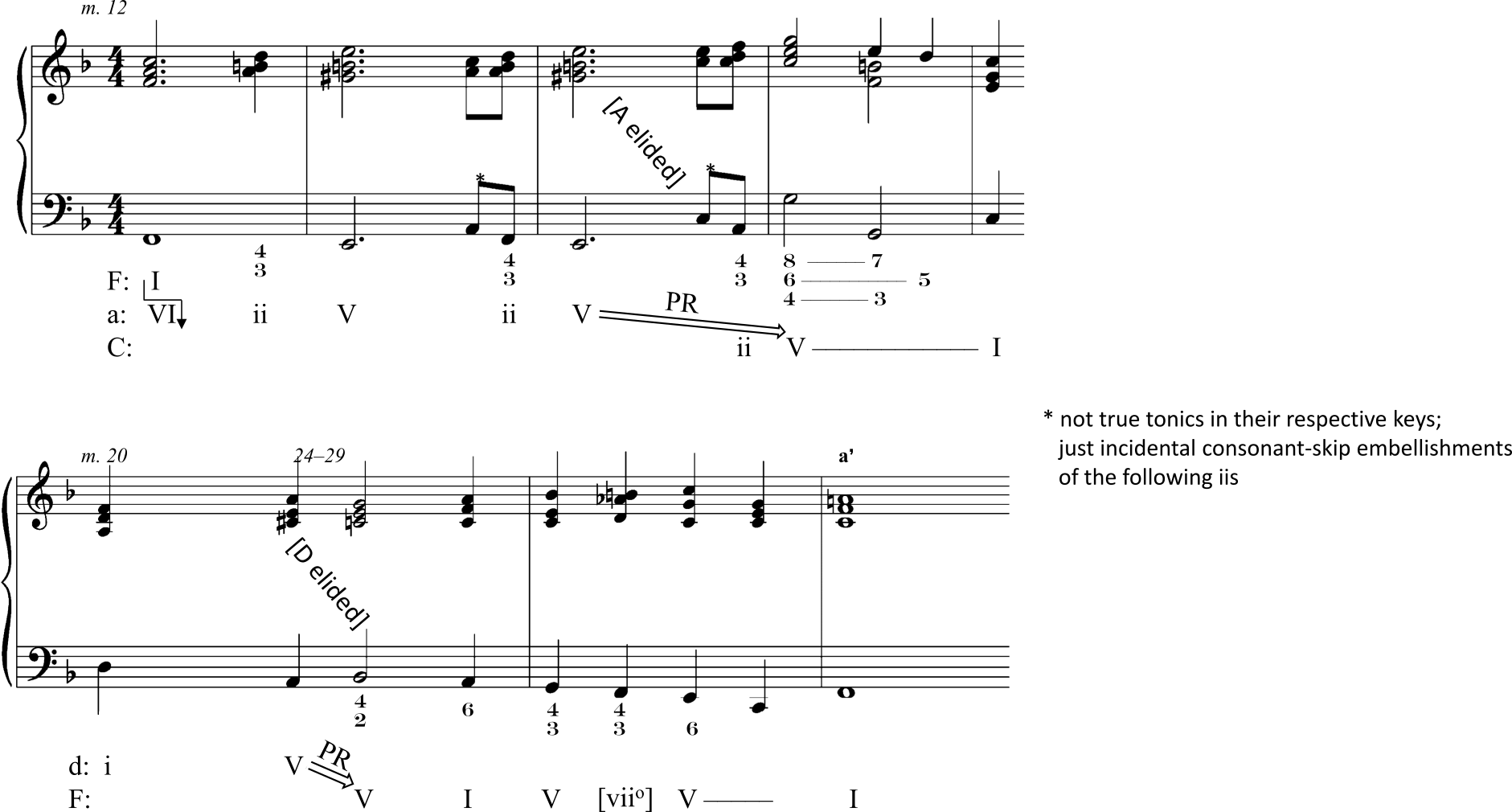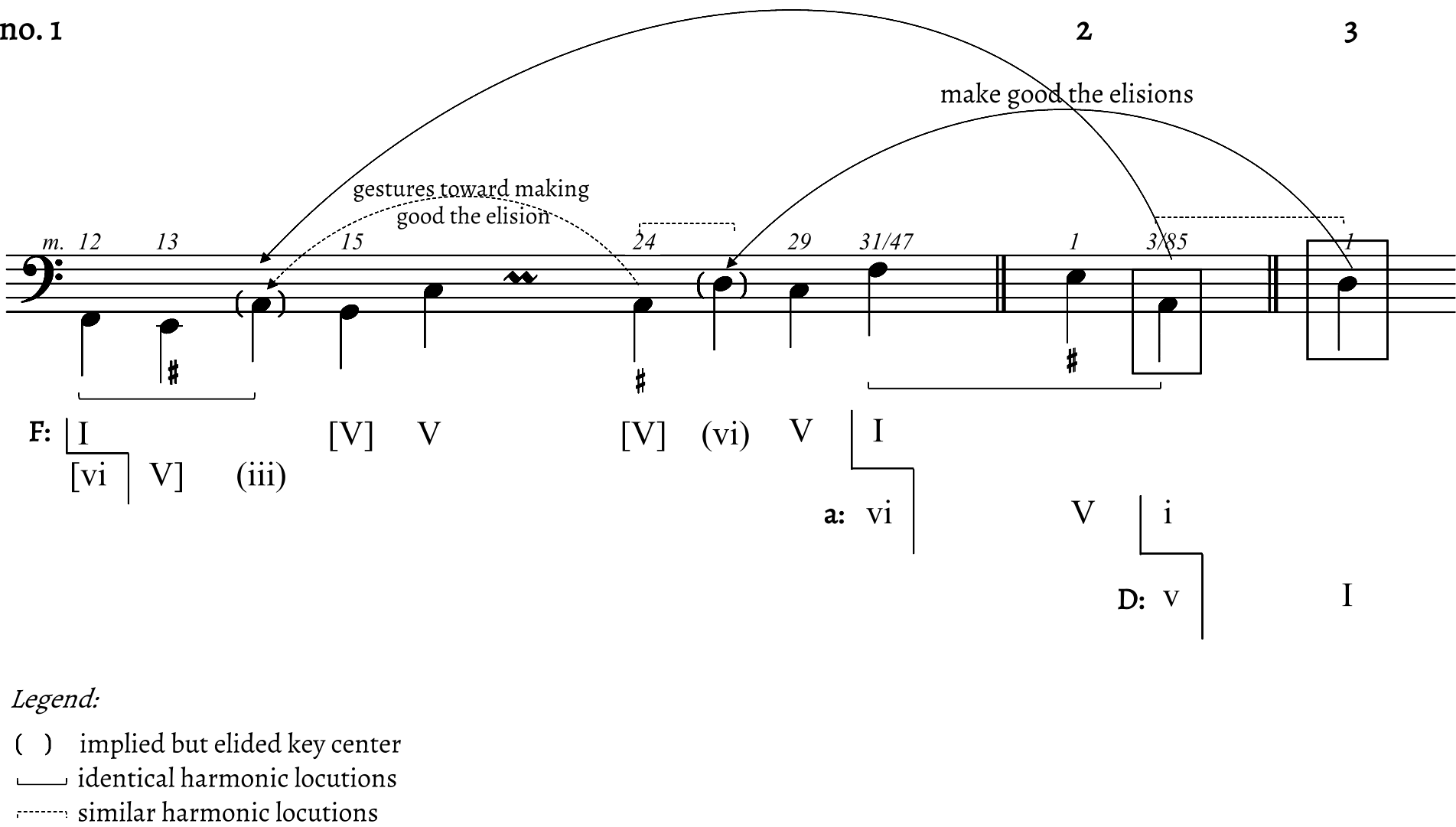Jeffrey Swinkin
Abstract
This essay demonstrates several ways in which Clara Schumann’s Four Fugitive Pieces, op. 15 is cyclically integrated. First, the four pieces trace a progressive (rather than static) tonal scheme. Second, they are interlinked by a taut motivic web. Third, no. 1 harbors a melodic implication that no. 4 realizes. Fourth, no. 1 distinctly implies yet elides two keys that are respectively articulated by nos. 2 and 3. Finally, no. 1 foments a hypermetric conflict that no. 3 settles, if briefly. The essay then suggests that the cycle questions its own unity by closing with a scherzo. As a light genre typically found in the second or third position of a four-movement cycle, it cannot bear the burden of definitively finishing the piece. In the end, Schumann’s op. 15 is a Romantic fragment, a notion I briefly elaborate.
Keywords and phrases: Clara Schumann, cyclic unity, ironic cycle, Romantic fragment
Introduction
Patrick McCreless states, “. . . since one of the remarkable achievements of tonal music . . . [during] the eighteenth and nineteenth centuries was to develop means by which multi-movement works . . . cohere, it is a reasonable task of music theory to try to gain a wider understanding of how such works function as wholes . . .” (1986, 6). In fact, music theorists have long been interested in multi-piece unity, and recent decades have seen astute analyses of such unity in the works of Franz Schubert, Felix Mendelssohn, Robert Schumann, and Johannes Brahms.1 Clara Schumann’s2 inventive cycles have received far less attention, for all the familiar reasons. This essay, in explaining several senses in which her Four Fugitive [or Fleeting] Pieces, op. 15 is a cycle, takes a small step toward rectifying that neglect.
As a point of departure, consider the four main ways, in Kevin Korsyn’s (2003, 100–109) typology, in which scholars have viewed Frédéric Chopin’s Preludes, op. 28, since I believe these categories are more broadly applicable. Chopin’s preludes have been, and pieces or songs of sets generally can be, regarded as monads, nomads, as forming a cryptocycle, or as forming an ironic cycle.
(1) Monads are autonomous and self-sufficient pieces; consequently, there is no question of broader, cyclic unity. (2) Nomads contain unstable or enigmatic elements that render those pieces less-than-fully closed and autonomous. A nomadic piece bears no particular relation to another piece in the same set, though its open-ended nature makes it amenable to being paired and played with other pieces, whether from the same set or from different ones. (3) In a cryptocycle, the pieces are unified by covert motivic connections.3 (4) Finally, in an ironic or paradoxical cycle, the pieces form a cohesive whole on one level while questioning that very cohesion on another. The need of the individual piece—to be utterly particular and self-complete—and that of the entire work—to fashion from its various pieces an integrated totality—cannot be fully reconciled.
In my estimation, the character pieces of Schumann’s op. 15 coalesce as a cryptocycle and also an ironic cycle. To prepare for demonstrating this, I survey various vehicles of cyclic integration, in addition to the veiled motivic interrelations Korsyn mentions.
First, successive pieces might unfold a single, central tonic, or, in other cases, follow a clear intervalic pattern—as when, for example, their keys stand thirds or perfect fifths apart. More locally, the final chord of one piece and the first chord of the next might form an intelligible harmonic progression. The most obvious case of such enjambment is where a piece ends on the dominant of the next piece’s tonic.
Second, though forms of a motive are generally unordered (in contradistinction to harmonic progressions and tonal relations, which are ordered [McCreless (1986, 6–8]), motive-forms may in fact unfold in a purposeful sequence, as when they chart some sort of emotional progression. Take the scenario in which a motive or theme is initially reticent—clothed in a soft dynamic and a thin texture—only later to return in a more grandiose guise (what E. T. Cone calls an “apotheosis”).4 For example, in Scriabin’s Piano Sonata No. 3 in F-sharp Minor, op. 23, the ethereal third-movement theme returns at the end of the Finale in gloriously bombastic form. Conversely, some works wistfully recall a theme from an earlier movement, as if the recalled theme represented a faint memory. Cases in point are Beethoven’s Piano Sonata in A, op. 101 and Schubert’s Piano Trio No. 3 in E-flat.5
Another inter-piece process entails an originary motive harboring a melodic implication that is realized by another motive-form in a later piece, as when a gap is subsequently filled. Yet another such process entails a piece presenting a “problem” and later pieces grappling with and ultimately resolving it. Such a problem may be (a) tonal: a conspicuous, perhaps unresolved dissonance; a chromatic tone whose function is uncertain; or a harmonic enigma;6 (b) metric: a metric dissonance or hypermetric conflict; or (c) formal: a formal ambiguity. Such a process may encompass some, not all, pieces in the work—the one presenting the conundrum and perhaps only one other responding to it—in which case the process will not by itself generate thoroughgoing unity across the set. Nonetheless, it can foster unity in conjunction with the other elements mentioned above.
In summary, pieces may be cyclically integrated by means of (a) a tonic expansion or tonal pattern; (b) motivic correspondences; (c) a motivic-emotional progression, such as thematic recall; and (d) a linear process such as implication–realization or problem–resolution. Four Fugitive Pieces, to which we now turn, avails itself of all four categories.
1. Cyclic Integration
1.1 Tonal Relations
The A minor of no. 2 can initially be seen to compose-out the F major of no. 1. Then, however, with the arrival of no. 3’s D major—in light of no. 4’s G major—the tonal center switches to G (Example 1a). No. 2’s A minor, which first belonged to F, now belongs to G, since a–D–G comprises a ii–V–I progression in G. (The example shows an alternate interpretation as well, by which F–a–D of nos. 1–3 forms a D-minor triad, the minor dominant of no. 4’s G.) The work’s tonal trajectory, then, is initially oriented toward F and is beginning-weighted; it is then reoriented toward G and is end-weighted (but only somewhat, for reasons I later discuss). Schumann’s overarching tonal structure is a flexible, fluctuating one.
Example 1b shows more local tonal connections, those between adjacent pieces. The last chord of no. 1, F major, segues into the E major that starts no. 2, as the two chords form VI–V, leading to i, in A minor (an “auxiliary cadence,” in Schenkerian parlance). Tellingly, that F/E dyad first crops up in no. 1’s main theme (m. 1), and also in no. 2’s (mm. 2–3), now tonally reconfigured as \hat{6}–\hat{5} (see the score). The B section of no. 2 reconfigures that dyad yet again, now as \hat{3}–\hat{4} in C, the relative major (m. 28). F–E is restored to \hat{6}–\hat{5} in mm. 54–55 (bass), as the B section prepares to return to A` and the home key. Thus, the tonal join between nos. 1 and 2 is thoroughly motivated—it takes inspiration from no. 1’s motivic F/E, a dyad that then continues as a motive throughout no. 2.
Similarly, the last chord of no. 3, D major, segues into the G and A7 that start no. 4, the two chords forming IV–V7, leading to I, in D major. (The G tonic is deferred. Though some might hear the opening G major as the first tonic Stufe followed by a dominant tonicization, I do not, simply because D receives a dominant before G does.) A full I–IV–V7–I progression in D thus straddles nos. 3 and 4.
The tonal continuity, then, between nos. 1 and 2 and also between nos. 3 and 4 is especially strong. Consequently, nos. 1 and 2 comprise one subgroup, nos. 3 and 4 another. That grouping also hinges on a pattern by which each pair starts with a relatively slow, meditative, lyrical piece—a song without words—and ends with a more lively, scherzando or scherzo piece in triple meter.
1.2 Motivic Correspondences
The first three pieces feature incipits that have underlying commonalities (Example 2a). Nos. 1–3 all start with an anacrustic figure leading to an accented dissonance on the next downbeat; notice in particular how nos. 1 and 3 share a motto consisting of exactly three eighth notes that alight on a dissonant downbeat. Moreover, no. 3’s main theme is an approximate inversion of no. 1’s. In addition, the interior (B-section) themes of nos. 2 and 3 not only sport second-measure accents but no. 2’s also recycles the pitches of no. 1’s theme, transplanting them to a different tonal environment (the pitch invariance is reinforced by registral invariance). No. 3’s interior theme, like its main theme, is a quasi-inversion of no. 1’s theme.
Another motive, which populates and links the first two pieces in particular, is the fully-diminished seventh chord containing pitch-class 2 (DIM2). As Example 2b shows, this collection first crops up in m. 8 of no. 1, where, as B^{\circ}7, it serves to darken a tonicized half cadence. The B section, situated in D minor, diverts to the Neapolitan in that key in mm. 22–23, tonicizing it with a vii^{\circ}7 that can be understood to enharmonically reinterpret the original vii^{\circ}7. The vii^{\circ}7 of the Neapolitan is then itself enharmonicized in the next measure, as vii^{\circ}7 of V in D minor. DIM2 thus at once facilitates the E-flat-major purple patch and is a portal by which to leave it. The antepenultimate measure of no. 1 (m. 45) brings a third enharmonic switch, one producing a common-tone^{\circ}7 inflecting the final tonic. That same ^{\circ}7 crops up at the start of no. 2, as vii^{\circ}7 of A minor, thus bridging nos. 1 and 2.7
1.3 Inter-Piece Processes
No. 1’s opening theme is replete with lugubrious sigh figures. The first of these is a descending fourth, a somewhat conspicuous gap that is filled only circuitously. As Example 3 illustrates, no sooner does the melody begin to seal the descending gap with ascending stepwise motion than another gap (a third) opens, which is forthwith filled by G. Had Schumann reversed the A and G in m. 2, she would have sidestepped this second gap and plugged A–E more directly and perceptibly. The melody, then, approximates and implies a linear fourth, a conjunct line.8
No. 1 periodically gestures toward filling that gap. In mm. 13–14, for instance, the bass descends A–G–F–E, shadowed by the alto a tenth above. Such figures proliferate across the next several measures as well. The end of no. 1 is ambivalent in this respect, for mm. 42–44 thrice superimpose an open fourth atop a linear fourth (now ascending). Thus, the original implication and its realization are in conflict—the potential has yet to be decisively actualized. Consequently, it is no surprise when the fourth-gap resurfaces in subsequent pieces. In particular, no. 3’s opening, as we have seen, closely correlates with no. 1’s and thus likewise maintains rather than realizes its implication.
No. 4, on the other hand, is launched in the soprano by a stepwise four-note gesture that could be understood to fill the open fourth of no. 1, though the pitches are different. This resolution is all the more ebullient by its ascending contour (in contrast to the original descending leap); by the triadic, fanfare-like riff that follows (mm. 3–4); and by the accented dissonance finally having been expunged—the downbeat of m. 3 is fully consonant (the first two measures together form an extended anacrusis to the third).
The ruminative B section corroborates the gesture in mm. 1–2 relating to and filling the fourth-leap that began no. 1. For, m. 45 re-presents the fourth as a gap (though now ascending) only to quickly caulk it. We might hear this theme as recalling the original dilemma but promptly assuring us that it is now only a harmless memory. That the B section is a reminiscence is suggested by two additional features. First, it recalls the A minor of no. 2: A minor is prominent in the first part of B and even more so in the middle part, since there it is tonicized, and by none other than the G\sharp^{\circ}7 (m. 57) familiar from no. 2. Second, the section invokes a chorale topic and is thus redolent of a remote music-historical past. To the extent that the chorale genre has soothingly spiritual connotations, its presence here might attest to a cycle-wide tension finally having been alleviated.
In short, in one sense no. 4 is the telos of the cycle, since it actualizes a long-standing melodic potential. In another sense, it looks back to the past, both of the work itself and of music more generally. Yet, such pastness is not at odds with no. 4 being a goal, for the memory affirms the melodic realization and topically fortifies it with a quality of pacification.
No. 1 harbors harmonic implications as well. Consider the enigmatic harmonic maneuver in mm. 12–15 of no. 1 (reduced in Example 4). Here, F major, after alighting on E major, retrospectively becomes a VI going to V within A minor (instantiating, yet again, the F/E motive). Yet, A minor is conspicuously absent; instead, E major flows into G major, and that to C. One might see the E–G–C as an arpeggiation—III–V–I—within the key of C, F’s dominant. However, since E is major and, coming from F, smacks of dominant function, it resists easy assimilation to C. Hence, it might be preferable to posit a neo-Riemannian transformation, parallel-relative (PR), between E and G. The latter interpretation does more justice to the diatonic discontinuity between E and G, a discontinuity owing to the elided A minor.
When A finally does appear, in m. 24, it is not as a tonic but as a dominant—V of vi, the main key of the B section. Here Schumann is perhaps appropriating a Viennese-Classical convention, by which a sonata-form retransition stands on the dominant not of the home key but of the relative minor. Sometimes, that “wrong” dominant discharges directly into the home-key tonic at the start of the recapitulation; other times, that wrong dominant yields to the right one at the last moment, during a “composed-out corridor of caesura-fill.”9 Schumann takes the latter route here, in m. 29 transforming A into C7. (She takes the same route in no. 3’s retransition as well.) Though A’s tonic, D minor, was previously present (m. 20), here it is absent, just as A itself was in mm. 13–15. Consequently, I interpret A–C–F in the same way I interpreted E–G–C, such that A–C is a diatonic non sequitur and C arises from PR. In other words, in this scenario, A is to C what E was to G.
If E and A are thus harmonic analogues—both dominants of unspoken tonics—it remains for E to progress to A (whether major or minor) directly. That happens at the start of no. 2, which materializes the tonic that was suppressed in no. 1 (Example 5). But no. 1 also plays a role here, for the end of no. 1/start of no. 2 traces the same F–E (VI–V) motion by which A was initially broached (mm. 12–13 of no. 1). Hence, in the join between the two pieces, the hitherto elusive A-minor tonic finds tangible form. Similarly, the D that was conspicuously absent in m. 29 of no. 1 is concretized by the key of no. 3 and the tonal join between nos. 2 and 3, though here the qualities are reversed—A major–(d minor) of no. 1 becomes a minor–D major of nos. 2–3.
The final cyclic process I shall discuss is a metric one. No. 1 presents a hypermetric conflict from the start (see Example 6). In one respect, m. 1 is strong since it initiates a chord progression (a tonic expansion) and also establishes the four-note rhythmic cell that the right hand will extend and render more melodically distinctive. In another respect, m. 1 is weak: precisely because the left hand is melodically nondescript, m. 1 has an introductory quality; that is also suggested by the right hand beginning with anacruses that lead into the second-measure appoggiatura, which lends emphasis to m. 2. Simply put, the accompaniment and melody each has its own hypermeter.10 (Notice that, in addition, each part is metrically dissonant against the bar line. [On metric dissonance, see Krebs 1999.]) The situation is (temporarily) rectified in the continuation phrase of that sentence, where, starting in m. 5, the right hand succumbs to the left hand’s hypermeter and thus the hands proceed more in tandem. The conflict recurs in no. 2. Here too, m. 1 is accentually ambiguous: on the one hand, it initiates, and is a crucial constituent of, the sentence’s basic idea; on the other, it has a decidedly anacrustic character.
No. 3, in its interior theme, points to a resolution of this hypermetric tension. Recall that the interior theme revisits no. 1’s theme in a quasi-inverted guise (Example 2a); the texture is very similar as well—note the arpeggiated accompaniment. Yet, the original right-hand gesture of three eighth notes leading to an agogic accent here occurs in diminution, such that it no longer spills into the next measure, affording it emphasis; the agogic accent does not have the hypermetric consequence it did in no. 1. Hence, although the rhythmic texture is intricate and contrametric stresses abound, those stresses are more local and the hypermeasure is stable, at least for the moment. (Notice that no. 1’s left-hand metric dissonance is also cleared up, for the arpeggiations now start on downbeats rather than upbeats.)
To summarize: we have seen that Schumann’s set coheres as a cycle in multiple respects: first, there is a progressive tonal scheme that initially centers around the opening F major, then the closing G major. More locally, chordal conduits bridge nos. 1 and 2, and nos. 3 and 4. Second, a taut motivic web interweaves almost all themes, both main and interior, and DIM2 tethers nos. 1 and 2. Third, no. 1 presents a melodic gap that no. 4 cheerfully seals. Fourth, nos. 2 and 3 successively and successfully articulate the two chords/keys that eluded no. 1. Finally, a hypermetric conflict in nos. 1 and 2 finds at least momentary resolution in no. 3. Schumann’s pieces, notwithstanding the winsome individuality of each, are thus tightly interconnected on several fronts and comprise a bona fide cycle.
2. Ironic Cyclicism
If Schumann’s op. 15 is substantially integrated, it also questions that very integration, ultimately failing to form a seamless whole. Though the set is cohesive in myriad ways, in the end it is less than a fully self-subsistent, self-contained entity. Schumann’s is an ironic cycle.
That is mainly because no. 4 is a paradoxical peroration. As we have seen, it confidently closes the work on two counts: first, its key of G is the goal of a prolongational span encompassing nos. 2–4; second, it arguably realizes a long-standing melodic potential. Yet, on two other counts, it fails to decisively close the work. First, as a Scherzo, it is the type of piece one would normally encounter as the second or third movement of a four-movement work, not as the final piece (though it is vaguely redolent of Haydn’s intermittent practice of using a minuet as a Finale). It is as if the Scherzo articulated the middle of a set whose ending will never materialize. (Actually, no. 4 was taken from the middle of another work: Schumann’s Piano Sonata in G Minor, of which it is the third, Scherzo movement. The Sonata was not published during her lifetime—not until 1991, in fact—and so she included the Scherzo as part of the Fugitive Pieces.11) Second, most of its thematic material is new, only minimally related to that of previous movements. Its relation to the fourth of the opening movement is rather subthematic (to borrow Carl Dahlhaus’s term [1991, 208]); on the surface, the themes could hardly be more different. Such thematic novelty this late in the piece points to a future beyond the confines of the piece.12 Both in its genre and thematic novelty, then, no. 4 conjures a fictional future, thus intimating that op. 15, while on one level a whole (for the reasons argued above), is on another level a mere part, a fragment of a larger counterfactual composition, so to speak.
Indeed, op. 15 is a fragment in the Romantic sense. In 1798, Friedrich Schlegel defined a Romantic fragment thus: “a fragment should be like a little work of art, complete in itself and separated from the rest of the universe like a hedgehog” (quoted in Rosen 1995, 48). I construe that statement as follows: a hedgehog’s quills lend it a distinctive shape and sharp boundaries (literally), thus separating it from the surrounding world. Yet, those selfsame quills also obscure that separation, for their interstices are, in a way, ambiguous: do those pockets of space belong to the animal, to the outside world, or to both? Thus, the very thing that sets the creature apart from its environment is that which (tentatively) connects it to its environment. A Romantic fragment, then, is at once complete and incomplete, torn away from a larger whole.
A perfect musical analogue of the hedgehog, a paradigmatic musical fragment, is the first song of Robert Schumann’s Dichterliebe, op. 48, “Im wunderschönen Monat Mai.” Harmonically, it begins in medias res, with an auxiliary cadence whose terminal tonic, F-sharp minor, fails to appear; essentially, the opening lingers on an unfulfilled dominant chord, C\sharp7. The song ends on that dominant as well, and with the same E\sharp5 hovering in the soprano. The song is thus perfectly rounded by the dominant, but that chord, naturally, also renders the song’s outer boundaries permeable.13 Just as with the hedgehog, the borders of Schumann’s song are distinctive and fuzzy at the same time. If the hedgehog is linked in a paradoxical way with its spatial surroundings, Schumann’s song is similarly linked with its temporal surroundings: the opening dominant points to a past tonic of which it is a continuation; the final dominant points to a future tonic to which it resolves. Crucially, that future is not to be equated with subsequent songs in Dichterliebe; to wit, the second song’s A major does not resolve first song’s dominant; nor does F-sharp minor prove a central key anywhere else in the cycle. The future to which the song points is not actual but imaginary.14
Just so, no. 4 rounds off the set at once resolutely and reluctantly, forming a boundary that is both firm and permeable. We might say that no. 4 is to op. 15 as a whole what the final V7 chord is to “Monat Mai.” In both cases, the ambiguous ending points to a wider whole, a fictional future beyond the borders of the piece. In a word, Schumann’s op. 15 is a Romantic fragment—it is both self-subsistent and not. Schumann’s set is an integrated whole, but, in the end, such wholeness proves tenuous. The work boasts so many ingenious inter-piece relations only for that unity, at the eleventh hour, to partially disintegrate.
References
Baker, Michael. 2018. “Multiply Interrupted Structure in Clara Schumann’s ‘Liebst du um Schönheit.” In Analytical Essays on Music by Women Composers: Secular and Sacred Music to 1900, edited by Laurel Parsons and Brenda Ravenscroft, 210–227. New York: Oxford University Press.
Carpenter, Patricia. 1988. “A Problem in Organic Form: Schoenberg’s Tonal Body.” Theory and Practice 13: 31–63.
Cone, Edward T. 1968. Musical Form and Musical Performance. New York: W. W. Norton and Company.
Dahlhaus, Carl. 1991. Ludwig Van Beethoven: Approaches to his Music, trans. Mary Whittall. Oxford: Clarendon Press.
Dineen. Murray. 2005. “The Tonal Problem as a Method of Analysis.” Theory and Practice 30: 69–96.
Dunsby, Jonathan. 1983. “The Multi-Piece in Brahms: Fantasien Op. 116.” In Brahms: Biographical, Documentary and Analytical Studies, edited by Robert Pascall, 167–190. Cambridge, UK: Cambridge University Press.
Eigeldinger, Jean-Jacques. 1988. “Twenty-Four Preludes Op. 28: Genre, Structure, Significance.” In Chopin Studies, edited by Jim Samson, 167–193. Cambridge, UK: Cambridge University Press.
Fisk, Charles. 2001. Returning Cycles: Contexts for the Interpretation of Schubert’s Impromptus and Last Sonatas. Berkeley: University of California Press.
Haimo, Ethan. 1995. Haydn’s Symphonic Forms: Essays in Compositional Logic. New York: Oxford University Press.
Hepokoski, James and Warren Darcy. 2006. Elements of Sonata Theory: Norms, Types, and Deformations in the Late Eighteenth-Century Sonata. New York: Oxford University Press.
Kaminsky, Peter. 1989. “Principles of Formal Structure in Schumann’s Early Piano Cycles.” Music Theory Spectrum 11 (2): 207–225.
Klein, Michael. 2004. “Chopin’s Fourth Ballade as Musical Narrative.” Music Theory Spectrum 26 (1): 23–56.
Korsyn, Kevin. 1991. “Towards a New Poetics of Musical Influence.” Music Analysis 10 (1/2): 3–72.
––––. 2003. Decentering Music: A Critique of Contemporary Musical Research. New York: Oxford University Press.
Krebs, Harald. 1999. Fantasy Pieces: Metrical Dissonance in the Music of Robert Schumann. New York: Oxford University Press.
Leikin, Anatole. 2015. The Mystery of Chopin’s Préludes. Farnham: Ashgate.
McCreless, Patrick. 1986. “Song Order in the Song Cycle: Schumann’s Liederkreis, Op. 39.” Music Analysis 5 (1): 5–28.
Pedneault-Deslauriers, Julie. 2016. “Bass-Line Melodies and Form in Four Piano and Chamber Works by Clara Wieck-Schumann.” Music Theory Spectrum 38 (2): 133–154.
Reich, Nancy B. 1985. Clara Schumann: The Artist and the Woman. Ithaca and London: Cornell University Press.
Rosen, Charles. 1995. The Romantic Generation. Cambridge, Mass: Harvard University Press.
Rothstein, William. 1995. “Beethoven with and without Kunstgespräng: Metrical Ambiguity Reconsidered.” Beethoven Forum 4, edited by Christopher Reynolds, Lewis Lockwood, and James Webster, 165–192. Lincoln and London: University of Nebraska Press.
Samarotto, Frank. 1999. “Strange Dimensions: Regularity and Irregularity in Deep Levels of Rhythmic Reduction.” In Schenker Studies 2, edited by Carl Schachter and Hedi Siegel. Cambridge, UK: Cambridge University Press.
Satyendra, Ramon. 1997. “Liszt’s Open Structures and the Romantic Fragment.” Music Theory Spectrum 19 (2): 184–205.
Schoenberg, Arnold. 1967. Fundamentals of Musical Composition, ed. Gerald Strang with Leonard Stein. London: Faber and Faber.
Taylor, Benedict. 2011. Mendelssohn, Time and Memory: The Romantic Conception of Cyclic Form. Cambridge, UK: Cambridge University Press.
Webster, James. 1991. Haydn’s ‘Farewell’ Symphony and the Idea of Classical Style: Through-Composition and Cyclic Integration in His Instrumental Music. Cambridge, UK: Cambridge University Press.
Notes
- See, respectively, Fisk 2001, Taylor 2011, Kaminsky 1989, and Dunsby 1983. Though cyclic form is most closely associated with nineteenth-century music, there are some notable precedents in Viennese Classicism, on which see Webster 1991.
- I use “Schumann” rather than “Wieck” because Clara composed op. 15 soon after she and Robert got married, in 1840 (though the set was not published until 1845).
- Eigeldinger 1988 and Leikin 2015 have taken pains to unearth such connections in Chopin’s Preludes.
- Cone 1968, 84. Also see Klein 2004, who locates apotheoses in Chopin’s First and Fourth Ballades (the Third has one as well).
- Explicit thematic recall is fairly rare in the eighteenth and early-nineteenth centuries but becomes much more common later in the nineteenth century.
- On “tonal problems,” see Schoenberg 1967, as well as Carpenter 1988 and Dineen 2005. For an effective analysis of tonal problematics in a multimovement work, visit Chapter 7 of Haimo 1995 (147–77), which takes up Haydn’s Symphony No. 81 in G Major.
- Here I should mention another source of cyclic integration that is related to motivic correspondence, since it is associative in nature. It is structural homology, the marked (rather than routine) recurrence across pieces of some harmonic, linear, or formal device. The descending linear basses that appear throughout op. 15 likely comprise one such homology: witness mm. 4–8 of no. 1; mm. 36–43 of no. 2; and mm. 13–18, 49–56, and 69–72 of no. 4. Julie Pedneault-Deslauriers 2016 cites such “bass-line melodies”— “remarkably dynamic, lyrical bass lines propelled by a strong descending impulse” (2016, 133)—as a general compositional trait of Clara Schumann and analyzes their harmonic and form-functional implications in several of her works, including op. 15, no. 1 (Ibid., 143–150).
- Contrast this opening with that, for instance, of Schumann’s “Liebst du um Schönheit,” one of three songs she contributed to her and Robert’s joint Liebesfrühling—her op. 12, his op. 37 (see Reich 1985, 238). “Liebst” starts with two unadorned fourth-leaps, ascending then descending, which are promptly and completely filled in. See Baker 2018 for a compelling analysis of this song.
- Hepokoski and Darcy 2006, 199. The authors cite standing on the dominant of iii as another “lower-level default” for retransitions.
- Rothstein 1996 detects many instances of this in Beethoven’s music, and explains them by recourse to Samarotto 1999’s notion of “shadow meter.”
- Incidentally, does that fact countermand my contention that no. 4 realizes an implication found in no. 1? Not necessarily; after all, there must be some reason why Schumann chose that piece and not some other to close op. 15. Perhaps, though she did not originally conceive nos. 1 and 4 as belonging to the same work, in hindsight she detected that no. 4 was indeed a fitting response to no. 1.
- Kevin Korsyn makes a similar observation with respect to Brahms’s “Romanze,” op. 118, no. 5; he deems its coda “. . . primarily future-oriented; it has an open-ended quality, pointing, as it were, to a future beyond the piece” (1991, 56). That quality stems in part from the new registers the coda activates.
- Liszt capitalized on this conceit of expanding a dominant for the duration of a piece. See Satyendra 1997, who distinguishes between pieces by Liszt that prolong dominants and those that prolong dissonant sonorities. Satyendra argues that the former, in triggering the expectation of resolution, gesture toward extra-opus futures and are thus musical fragments.
- For a fuller discussion of “Monat Mai,” see Rosen 1995, 41–48. Chopin’s Prelude in F Major, op. 28, no. 23 is another quintessential musical fragment: in ending on an F7 chord, it has a soft final boundary that intimates futurity, some other piece with which this prelude will connect; but that piece is not the next one in the set, for no. 24 is in D minor, not B-flat major.
